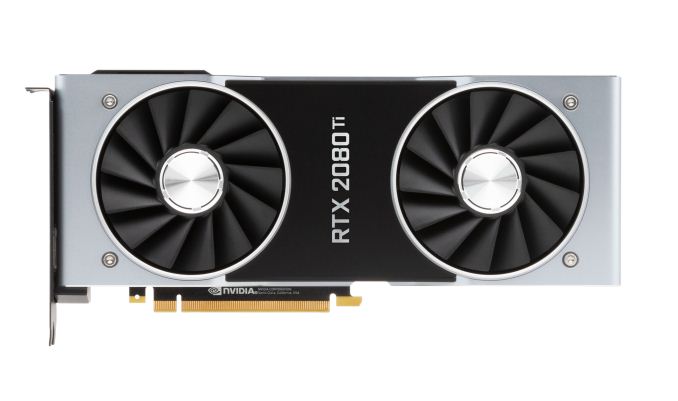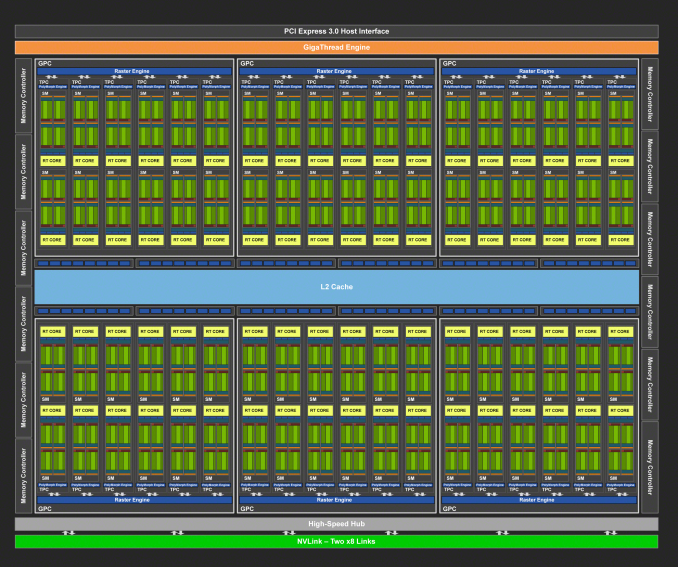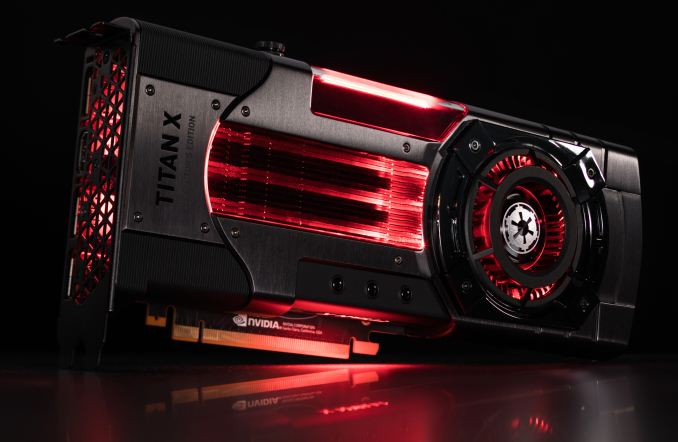The NVIDIA GeForce RTX 2080 Ti & RTX 2080 Founders Edition Review: Foundations For A Ray Traced Future
by Nate Oh on September 19, 2018 5:15 PM EST- Posted in
- GPUs
- Raytrace
- GeForce
- NVIDIA
- DirectX Raytracing
- Turing
- GeForce RTX

While it was roughly 2 years from Maxwell 2 to Pascal, the journey to Turing has felt much longer despite a similar 2 year gap. There’s some truth to the feeling: looking at the past couple years, there’s been basically every other possible development in the GPU space except next-generation gaming video cards, like Intel’s planned return to discrete graphics, NVIDIA’s Volta, and cryptomining-specific cards. Finally, at Gamescom 2018, NVIDIA announced the GeForce RTX 20 series, built on TSMC’s 12nm “FFN” process and powered by the Turing GPU architecture. Launching today with full general availability is just the GeForce RTX 2080, as the GeForce RTX 2080 Ti was delayed a week to the 27th, while the GeForce RTX 2070 is due in October. So up for review today is the GeForce RTX 2080 Ti and GeForce RTX 2080.
But a standard new generation of gaming GPUs this is not. The “GeForce RTX” brand, ousting the long-lived “GeForce GTX” moniker in favor of their announced “RTX technology” for real time ray tracing, aptly underlines NVIDIA’s new vision for the video card future. Like we saw last Friday, Turing and the GeForce RTX 20 series are designed around a set of specialized low-level hardware features and an intertwined ecosystem of supporting software currently in development. The central goal is a long-held dream of computer graphics researchers and engineers alike – real time ray tracing – and NVIDIA is aiming to bring that to gamers with their new cards, and willing to break some traditions on the way.
| NVIDIA GeForce Specification Comparison | ||||||
| RTX 2080 Ti | RTX 2080 | RTX 2070 | GTX 1080 | |||
| CUDA Cores | 4352 | 2944 | 2304 | 2560 | ||
| Core Clock | 1350MHz | 1515MHz | 1410MHz | 1607MHz | ||
| Boost Clock | 1545MHz FE: 1635MHz |
1710MHz FE: 1800MHz |
1620MHz FE: 1710MHz |
1733MHz | ||
| Memory Clock | 14Gbps GDDR6 | 14Gbps GDDR6 | 14Gbps GDDR6 | 10Gbps GDDR5X | ||
| Memory Bus Width | 352-bit | 256-bit | 256-bit | 256-bit | ||
| VRAM | 11GB | 8GB | 8GB | 8GB | ||
| Single Precision Perf. | 13.4 TFLOPs | 10.1 TFLOPs | 7.5 TFLOPs | 8.9 TFLOPs | ||
| Tensor Perf. (INT4) | 430TOPs | 322TOPs | 238TOPs | N/A | ||
| Ray Perf. | 10 GRays/s | 8 GRays/s | 6 GRays/s | N/A | ||
| "RTX-OPS" | 78T | 60T | 45T | N/A | ||
| TDP | 250W FE: 260W |
215W FE: 225W |
175W FE: 185W |
180W | ||
| GPU | TU102 | TU104 | TU106 | GP104 | ||
| Transistor Count | 18.6B | 13.6B | 10.8B | 7.2B | ||
| Architecture | Turing | Turing | Turing | Pascal | ||
| Manufacturing Process | TSMC 12nm "FFN" | TSMC 12nm "FFN" | TSMC 12nm "FFN" | TSMC 16nm | ||
| Launch Date | 09/27/2018 | 09/20/2018 | 10/2018 | 05/27/2016 | ||
| Launch Price | MSRP: $999 Founders $1199 |
MSRP: $699 Founders $799 |
MSRP: $499 Founders $599 |
MSRP: $599 Founders $699 |
||
As we discussed at the announcement, one of the major breaks is that NVIDIA is introducing GeForce RTX as the full upper tier stack with x80 Ti/x80/x70 stack, where it has previously tended towards the x80/x70 products first, and the x80 Ti as a mid-cycle refresh or competitive response. More intriguingly, each GeForce card has their own distinct GPU (TU102, TU104, and TU106), with direct Quadro and now Tesla variants of TU102 and TU104. While we covered the Turing architecture in the preceding article, the takeaway is that each chip is proportionally cut-down, including the specialized RT Cores and Tensor Cores; with clockspeeds roughly the same as Pascal, architectural changes and efficiency enhancements will be largely responsible for performance gains, along with the greater bandwidth of 14Gbps GDDR6.
And as far as we know, Turing technically did not trickle down from a bigger compute chip a la GP100, though at the architectural level it is strikingly similar to Volta/GV100. Die size brings more color to the story, because with TU106 at 454mm2, the smallest of the bunch is frankly humungous for a FinFET die nominally dedicated for a x70 GeForce product, and comparable in size to the 471mm2 GP102 inside the GTX 1080 Ti and Pascal Titans. Even excluding the cost and size of enabled RT Cores and Tensor Cores, a slab of FinFET silicon that large is unlikely to be packaged and priced like the popular $330 GTX 970 and still provide the margins NVIDIA is pursuing.
These observations are not so much to be pedantic, but more so to sketch out GeForce Turing’s positioning in relation to Pascal. Having separate GPUs for each model is the most expensive approach in terms of research and development, testing, validation, extra needed fab tooling/capacity – the list goes on. And it raises interesting questions on the matter of binning, yields, and salvage parts. Though NVIDIA certainly has the spare funds to go this route, there’s surely a better explanation than Turing being primarily designed for a premium-priced consumer product that cannot command the margins of professional parts. These all point to the known Turing GPUs as oriented for lower-volume, and NVIDIA’s financial quarterly reports indicate that GeForce product volume is a significant factor, not just ASP.
And on that note, the ‘reference’ Founders Edition models are no longer reference; the GeForce RTX 2080 Ti, 2080, and 2070 Founders Editions feature 90MHz factory overclocks and 10W higher TDP, and NVIDIA does not plan to productize a reference card themselves. But arguably the biggest change is the move from blower-style coolers with a radial fan to an open air cooler with dual axial fans. The switch in design improves cooling capacity and lowers noise, but with the drawback that the card can no longer guarantee that it can cool itself. Because the open air design re-circulates the hot air back into the chassis, it is ultimately up to the chassis to properly exhaust the heat. In contrast, a blower pushes all the hot air through the back of the card and directly out of the case, regardless of the chassis airflow or case fans.
All-in-all, NVIDIA is keeping the Founders Edition premium, which is now $200 over the baseline ‘reference.’ Though AIB partner cards are also launching today, in practice the Founders Edition pricing is effectively the retail price until the launch rush has subsided.
The GeForce RTX 20 Series Competition: The GeForce GTX 10 Series
In the end, the preceding GeForce GTX 10 series ended up occupying an odd spot in the competitive landscape. After its arrival in mid-2016, only the lower end of the stack had direct competition, due to AMD’s solely mainstream/entry Polaris-based Radeon RX 400 series. AMD’s RX 500 series refresh in April 2017 didn’t fundamentally change that, and it was only until August 2017 that the higher-end Pascal parts had direct competition with their generational equal in RX Vega. But by that time, the GTX 1080 Ti (not to mention the Pascal Titans) was unchallenged. And all the while, an Ethereum-led resurgence of mining cryptocurrency on video cards was wreaking havoc on GPU pricing and inventory, first on Polaris products, then general mainstream parts, and finally affecting any and all GPUs.
Not that NVIDIA sat on their laurels with Vega, releasing the GTX 1070 Ti anyhow. But what was constant was how the pricing models evolved with the Founders Editions schema, the $1200 Titan X (Pascal), and then $700 GTX 1080 Ti and $1200 Titan Xp. Even the $3000 Titan V maintained gaming cred despite diverging greatly from previous Titan cards as firmly on the professional side of prosumer, basically allowing the product to capture both prosumers and price-no-object enthusiasts. Ultimately, these instances coincided with the rampant cryptomining price inflation and was mostly subsumed by it.
So the higher end of gaming video cards has been Pascal competing with itself and moving up the price brackets. For Turing, the GTX 1080 Ti has become the closest competitor. RX Vega performance hasn’t fundamentally changed, and the fallout appears to have snuffed out any Vega 10 parts, as well as Vega 14nm+ (i.e. 12nm) refreshes. As a competitive response, AMD doesn’t have many cards up their sleeves except the ones already played – game bundles (such as the current “Raise the Game” promotion), FreeSync/FreeSync 2, other hardware (CPU, APU, motherboard) bundles. Other than that, there’s a DXR driver in the works and a machine learning 7nm Vega on the horizon, but not much else is known, such as mobile discrete Vega. For AMD graphics cards on shelves right now, RX Vega is still hampered by high prices and low inventory/selection, remnants of cryptomining.
For the GeForce RTX 2080 Ti and 2080, NVIDIA would like to sell you the RTX cards as your next upgrade regardless of what card you may have now, essentially because no other card can do what Turing’s features enable: real time raytracing effects ((and applied deep learning) in games. And because real time ray tracing offers graphical realism beyond what rasterization can muster, it’s not comparable to an older but still performant card. Unfortunately, none of those games have support for Turing’s features today, and may not for some time. Of course, NVIDIA maintains that the cards will provide expected top-tier performance in traditional gaming. Either way, while Founders Editions are fixed at their premium MSRP, custom cards are unsurprisingly listed at those same Founders Edition price points or higher.
| Fall 2018 GPU Pricing Comparison | |||||
| AMD | Price | NVIDIA | |||
| $1199 | GeForce RTX 2080 Ti | ||||
| $799 | GeForce RTX 2080 | ||||
| $709 | GeForce GTX 1080 Ti | ||||
| Radeon RX Vega 64 | $569 | ||||
| Radeon RX Vega 56 | $489 | GeForce GTX 1080 | |||
| $449 | GeForce GTX 1070 Ti | ||||
| $399 | GeForce GTX 1070 | ||||
| Radeon RX 580 (8GB) | $269/$279 | GeForce GTX 1060 6GB (1280 cores) |
|||













337 Comments
View All Comments
mapesdhs - Thursday, September 27, 2018 - link
It also glosses over the huge pricing differences and the fact that most gamers buy AIB models, not reference cards.noone2 - Thursday, September 20, 2018 - link
Not sure why people are so negative about these and the prices. Sell your old card and amortize the cost over how long you'll keep the new one. So maybe $400/year (less if you keep it longer).If you're a serious gamer, are you really not willing to spend a few hundred dollars per year on your hardware? I mean, the performance is there and it's somewhat future proofed (assuming things take off for RT and DLSS.)
A bowling league (they still have those?) probably costs more per year than this card. If you only play Minecraft I guess you don't need it, but if you want the highest setting in the newest games and potentially the new technology, then I think it's worth it.
milkod2001 - Friday, September 21, 2018 - link
Performance is not there. Around 20% actual performance boost is not very convincing especially due much higher price. How can you be positive about it?Future tech promise doesn't add that much and it is not clear if game developers will bother.
When one spend $1000 of GPU it has to deliver perfect 4k all maxed gaming and NV charges ever more. This is a joke, NV is just testing how much they can squeeze of us until we simply don't buy.
noone2 - Friday, September 21, 2018 - link
The article clearly says that the Ti is 32% better on average.The idea about future tech is you either do it and early adopters pay for it in hopes it catches on, or you never do it and nothing ever improves. Game developers don't really create technology and then ask hardware producers to support it/figure out how to do it. Dice didn't knock on Nvidia's door and pay them to figure out how to do ray tracing in real time.
My point remains though: If this is a favorite hobby/pass-time, then it's a modest price to pay for what will be hundreds of hours of entertainment and the potential that ray tracing and DLSS and whatever else catches on and you get to experience it sooner rather than later. You're saying this card is too expensive, yet I can find console players who think a $600 video game is too expensive too. Different strokes for different folks. $1100 is not terrible value. You talking hundreds of dollars here, not 10s of thousands of dollars. It's drop in the bucket in the scope of life.
mapesdhs - Thursday, September 27, 2018 - link
So Just Buy It then? Do you work for toms? :DTheJian - Thursday, September 20, 2018 - link
"Ultimately, gamers can't be blamed for wanting to game with their cards, and on that level they will have to think long and hard about paying extra to buy graphics hardware that is priced extra with features that aren't yet applicable to real-world gaming, and yet only provides performance comparable to previous generation video cards."So, I guess I can't read charts, because I thought they said 2080ti was massively faster than anything before it. We also KNOW devs will take 40-100% perf improvements seriously (already said such, and NV has 25 games being worked on now coming soon with support for their tech) and will support NV's new tech since they sell massively more cards than AMD.
Even the 2080 vs. 1080 is a great story at 4k as the cards part by quite a margin in most stuff.
IE, battlefield 1, 4k test 2080fe scores 78.9 vs. 56.4 for 1080fe. That's a pretty big win to scoff at calling it comparable is misleading at best correct? Far Cry 5 same story, 57 2080fe, vs. 42 for 1080fe. Again, pretty massive gain for $100. Ashes, 74 to 61fps (2080fe vs. 1080fe). Wolf2 100fps for 2080fe, vs. 60 for 1080fe...LOL. Well, 40% is, uh, "comparable perf"...ROFL. OK, I could go on but whatever dude. Would I buy one if I had a 1080ti, probably not unless I had cash to burn, but for many that usually do buy these things, they just laughed at $100 premiums...ROFL.
Never mind what these cards are doing to the AMD lineup. No reason to lower cards, I'd plop them on top of the old ones too, since they are the only competition. When you're competing with yourself you just do HEDT like stuff, rather than shoving down the old lines. Stack on top for more margin and profits!
$100 for future tech and a modest victory in everything or quite a bit more in some things, seems like a good deal to me for a chip we know is expensive to make (even the small one is Titan size).
Oh, I don't count that fold@home crap, synthetic junk as actual benchmarks because you gain nothing from doing it but a high electric bill (and a hot room). If you can't make money from it, or play it for fun (game), it isn't worth benchmarking something that means nothing. How fast can you spit in the wind 100 times. Umm, who cares. Right. Same story with synthetics.
mapesdhs - Thursday, September 27, 2018 - link
It's future tech that cannot deliver *now*, so what's the point? The performance just isn't there, and it's a pretty poor implementation of what they're boasting about anyway (I thought the demos looked generally awful, though visual realism is less something I care about now anyway, games need to better in other ways). Fact is, the 2080 is quite a bit more expensive than a new 1080 Ti for a card with less RAM and no guarantee these supposed fancy features are going to go anywhere anyway. The 2080 Ti is even worse; it has the speed in some cases, but the price completely spoils the picture, where I am the 2080 Ti is twice the cost of a 1080 Ti, with no VRAM increase either.NVIDIA spent the last 5 years pushing gamers into high frequency displays, 4K and VR. Now they're trying to do a total about face. It won't work.
lenghui - Thursday, September 20, 2018 - link
Thanks for rushing the review out. BTW, the auto-play video on every AT page has got to stop. You are turning into Tom's Hardware.milkod2001 - Friday, September 21, 2018 - link
They are both owned by Purch. Marketing company responsible for those annoying auto play videos and the lowest crap possible From the web section. They go with motto: Ad clicks over anything. Don't think it will change anytime soon. Anand sold his soul twice to Apple and also his web to Purch.mapesdhs - Thursday, September 27, 2018 - link
One can use Ublock Origin to prevent those jw-player vids.